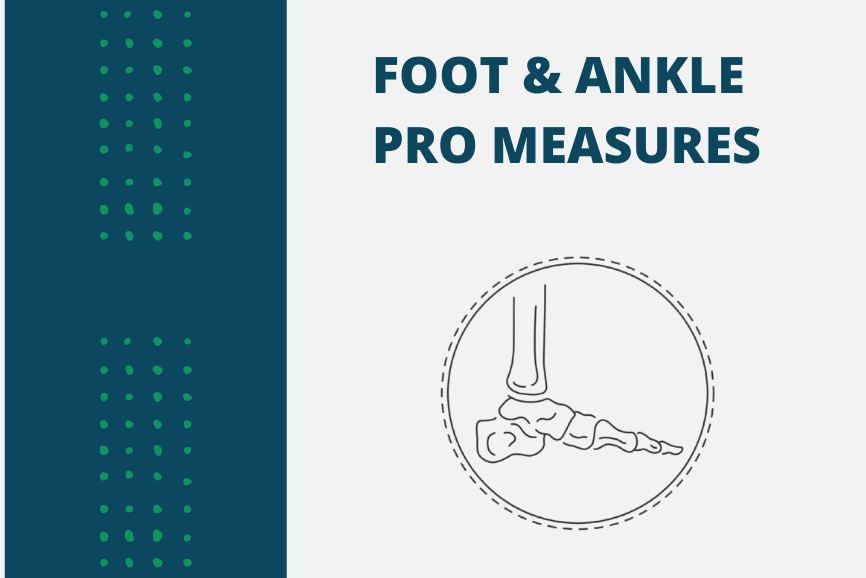Update: On March 21, 2021 AAOS confirmed with CODE that they are no longer supporting or updating the AAOS Foot and Ankle tool.
—–
When it comes to evaluating foot and ankle outcomes post intervention, clinicians and researchers have traditionally used objective-based measures to help determine treatment effectiveness by measuring patient metrics, assessing impairments in range of motion and quantifying improvements in strength.
More recently however clinicians have started to move towards patient-reported outcome measures (PROs) to monitor treatment effectiveness. These PRO tools have been found to better reflect a patient’s own experience of pain relief, functional activity, and quality of life. One of these measures is the American Academy of Orthopedic Surgeons (AAOS) foot and ankle questionnaire that was developed in 2005.
The AAOS foot and ankle questionnaire is a patient-administrated 25-item survey specifically developed for foot and ankle-related disability. The questionnaire is divided into two scales, the Foot and Ankle Core scale, comprised of 20 questions and the Shoe Comfort Scale with five questions. The questions themselves are distributed amongst five different categories: Pain (9 items), function (6 items), stiffness and swelling (2 items), giving way (3 items) and shoe comfort (5 items). Answers are then measured on a scale of 1 to 5 or 6, with1 being the best outcome score.
Following completion of the survey, responses then need to be entered onto a computerized AAOS spreadsheet (which is readily available on the AAOS website) and an overall standardized percentage score (0-100) is automatically computed. Higher scores indicate better foot function.
The AAOS measures differs from many others because after patient completion of the survey, in order to obtain results, clinicians must access the online scoring sheet. Patient responses are plugged into the spreadsheet and percentage scores are automatically calculated.
Due to the complexity of the formula used by the AAOS questionnaire, practitioners cannot easily calculate patient scores themselves in a reasonable amount of time. Although the AAOS questionnaire is a good outcome measure for many foot and ankle disorders, the scoring structure might make some shy away from using it.
See The Foot & Ankle PRO Tools Guide
Put your best foot forward! We’ve evaluated the strengths and considerations for all the most popular Foot & Ankle PRO measures.
or Schedule a Call with a CODE PRO Expert
Strengths
In addition to the traditional measures used to assess treatment outcomes, the use of patient-reported measures of function is increasing in popularity and the AAOS foot and ankle questionnaire is good example of a reliable knee-specific outcome measure. In an extensive comparison with other foot and ankle outcomes, Suk et al. found that the AAOS foot and ankle questionnaire was also consistently rated highly for its methodological qualities (1).
Considerations
Compared with other foot-specific questionnaires (FHSQ, FFI and MFPDI) the AAOS foot and ankle measure has limited use in outcome studies and clinical trials. To date there are very few published reports of the AAOS foot and ankle questionnaire being used in outcomes research.
Furthermore, the AAOS foot and ankle questionnaire, similar to several other foot-related patient-reported outcome measures, lacks information regarding the minimum detectable difference and minimum clinically important difference (2). These are terms used to help describe small amounts of change in an outcome that might be considered important by the patient or clinician. An absence of these measures limits the clinical usability of a reporting measure.
Another setback of the AAOS questionnaire is the need for clinicians to go online and enter patient results (from the questionnaire) in order to obtain scores. This may prove to be cumbersome, time-consuming and impractical for some healthcare providers.
Overall, the AAOS foot and ankle questionnaire is a reliable patient-reported measure but as it is clinical in nature, some researchers suggest combining it with another quality of life instrument to fully evaluate a patient’s foot health–related quality of life.
License
Status Unknown
About CODE Technology
CODE Technology is a Patient-Reported Outcome (PRO) vendor, ready to take PRO collection off your hands forever. At CODE we handle all data collection as a service, 100% outside of the office, you won’t even know we’re there. CODE offers robust reporting, benchmarking, and has a dedicated support team – not robots – to help you along the way. We’ll have you up and running in 30 days with zero hardware investment, zero manual data entry, and with zero disruption to your office. Click here to learn more about how CODE works.
References
- Musculoskeletal outcome measurements and instruments. 2009. Suk et al.
<http://www.thieme.com/books-main/orthopaedic-surgery/product/1003-musculoskeletal-outcomes-measures-and-instruments> - RISKOWSKI, J. L., HAGEDORN, T. J., & HANNAN, M. T. (2011). Measures of Foot Function, Foot Health, and Foot Pain. Arthritis Care & Research, 63(0 11), S229–S239.
<http://www.ncbi.nlm.nih.gov/pmc/articles/PMC4155931/>

